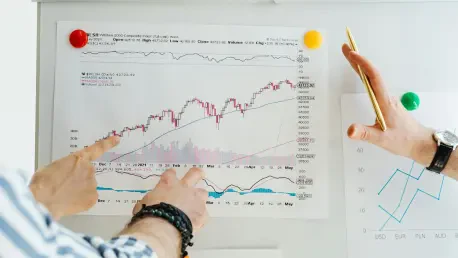In a surprising turn of events, Asian stock markets are experiencing a significant upswing, mirroring record-breaking gains on Wall Street, even as the U.S. grapples with a government shutdown, raising intriguing questions about investor sentiment. This resilience in global equities, particularly in technology-heavy indices, highlights a fascinating disconnect between political uncertainties and financial confidence as investors prioritize long-term prospects over immediate crises. Despite political gridlock in the U.S. delaying critical economic data and casting shadows over policy decisions, the focus seems to have shifted toward growth opportunities in the tech sector and export potential. Markets across Asia, from South Korea to Taiwan, are riding a wave of optimism driven by semiconductor giants and strategic partnerships. This phenomenon suggests an intricate balance of economic signals and market behavior, offering a compelling narrative of adaptation and opportunity in turbulent times.
Global Market Trends and Technology’s Role
Tech Sector Drives Asian Gains
The surge in Asian equities is largely fueled by remarkable performances in the technology sector, with major players setting the pace for broader market gains. South Korea’s Kospi index jumped an impressive 2.9%, propelled by Samsung Electronics, which saw a 4.6% increase, and SK Hynix, soaring by 10.8%, following a key partnership with OpenAI to supply memory chips for data hubs. Taiwan’s Taiex also climbed 1.7%, with TSMC shares rising 3.3%, reflecting strong investor confidence in semiconductor demand. Even Japan’s Nikkei 225 edged up by 0.3%, while Hong Kong’s Hang Seng advanced 1.3%, showcasing a regional trend of tech-driven optimism. Australia’s S&P/ASX 200 added 1% to the rally, partly due to robust gold mining stocks. This collective upward movement underscores how technology, particularly innovations in chips and data infrastructure, has become a cornerstone of market strength, overshadowing external disruptions and fostering a sense of stability across diverse economies.
Wall Street’s Influence on Asian Optimism
Wall Street’s recent record highs have played a pivotal role in bolstering confidence among Asian investors, creating a ripple effect across global markets. The S&P 500, Dow Jones Industrial Average, and Nasdaq composite achieved new peaks with gains of 0.3%, 0.1%, and 0.4%, respectively, signaling robust economic expectations despite domestic challenges. This performance has encouraged a similar bullish sentiment in Asia, where markets are drawing inspiration from U.S. tech advancements and the anticipation of export growth. Analysts from the Nomura Group have highlighted the potential for semiconductor exports to drive economic momentum, a perspective that seems to eclipse concerns over U.S. tariffs on other sectors. The ability of Asian markets to align with Wall Street’s trajectory illustrates an interconnected financial landscape where positive developments in one region can significantly uplift others, even amidst political and economic uncertainties.
Economic Uncertainties and Market Resilience
U.S. Shutdown and Delayed Economic Data
The U.S. government shutdown, which commenced just after midnight, has introduced a layer of complexity to the economic landscape by potentially delaying vital reports such as the Labor Department’s jobs data. This interruption poses challenges for policymakers and investors alike, as timely information is crucial for informed decision-making. Compounding the issue, a recent ADP Research survey indicated a loss of 32,000 jobs in September, alongside downward revisions for the prior month, pointing to underlying weaknesses in non-government employment, especially in the Midwest. Such mixed signals create uncertainty about the true state of the U.S. economy and the Federal Reserve’s capacity to manage interest rate adjustments effectively. While markets have so far shrugged off these concerns, the absence of clear data could eventually weigh on sentiment if prolonged, highlighting the delicate balance between immediate crises and long-term economic strategies.
Market Sentiment Amid Policy Risks
Despite the looming uncertainties tied to the U.S. shutdown and disappointing economic indicators, global stock markets have demonstrated an extraordinary capacity to focus on growth narratives. Investors seem undeterred by the potential for delayed policy responses or the risk of missteps in interest rate cuts by the Federal Reserve, which could trigger a downturn if expectations are unmet. Instead, the prevailing sentiment, as noted by Stephen Innes of SPI Asset Management, is one of transforming crises into opportunities for higher prices. This mindset is further evidenced by rising U.S. futures and oil prices, with benchmark crude oil increasing by 30 cents to $62.08 per barrel and Brent crude up by the same margin to $65.65. Even fluctuations in currency and commodity markets, such as a slight strengthening of the U.S. dollar against the Japanese yen and a dip in gold prices by $6.80 to $3,890.70 per ounce, have not dampened the overall bullish outlook. This resilience reflects a broader trend of prioritizing technological and export-driven progress over short-term political disruptions.
Reflecting on Market Dynamics
Lessons from a Tech-Driven Rally
Looking back, the recent rally in Asian shares amidst U.S. political challenges revealed a profound shift in investor priorities, where technology emerged as a dominant force. The impressive gains in indices like South Korea’s Kospi and Taiwan’s Taiex, driven by semiconductor leaders, highlighted how innovation and strategic partnerships could overshadow systemic risks. This period demonstrated that markets often found strength in sector-specific advancements, even when broader economic data painted a less rosy picture. The mirroring of Wall Street’s record highs by Asian equities further underscored the interconnectedness of global finance, showing how positive momentum could transcend regional boundaries. Reflecting on these events, it became clear that the tech sector’s robustness offered a buffer against uncertainty, providing a valuable lesson in the power of targeted growth areas to sustain market confidence during turbulent times.
Future Considerations for Investors
As the dust settled on this wave of market activity, attention turned toward actionable strategies for navigating the evolving financial landscape. Investors were reminded to closely monitor developments in the tech sector, particularly in semiconductors, as a key driver of growth amidst lingering U.S. policy delays. Keeping an eye on alternative economic indicators became essential, given the potential for continued disruptions in official data releases due to government shutdowns. Additionally, the fluctuating dynamics of oil, currency, and commodity markets suggested a need for diversified portfolios to mitigate risks from sudden shifts. Moving forward, balancing optimism with caution emerged as a critical approach, ensuring that enthusiasm for tech-driven gains did not blind stakeholders to underlying economic fragilities. This reflective period emphasized the importance of adaptability, urging market participants to prepare for both opportunities and challenges in an unpredictable global economy.









